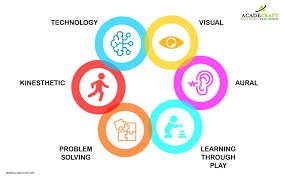Introduction
Welcome to our comprehensive guide to multimodal learning approaches! In this blog post, we will explore what multimodal learning is, why it is important, and how you can incorporate it into your own learning journey. Whether you are a student, a teacher, or someone who is simply interested in expanding their knowledge, this guide will provide you with valuable insights and practical tips.
What is Multimodal Learning?
Multimodal learning refers to the process of acquiring knowledge and skills through multiple sensory channels. It recognizes that individuals have different learning styles and preferences, and aims to cater to these diverse needs by incorporating various modes of communication, such as visual, auditory, kinesthetic, and tactile.
Traditionally, education has primarily focused on verbal and written communication, neglecting the power of other sensory channels. However, research has shown that incorporating multiple modes of learning can enhance understanding, engagement, and retention of information.
The Importance of Multimodal Learning
There are several reasons why multimodal learning is important:
1. Enhanced Understanding
When information is presented through multiple sensory channels, it becomes easier for learners to grasp and comprehend complex concepts. For example, a visual representation of a mathematical equation can help students understand the underlying principles more effectively than a written explanation alone.
2. Increased Engagement
By incorporating different modes of learning, educators can create a more engaging and interactive learning experience. This can help to capture and maintain students’ attention, leading to improved motivation and participation.
3. Improved Retention
Studies have shown that when information is presented using multiple sensory channels, learners are more likely to remember and retain that information over time. This is because different modes of learning activate different parts of the brain, creating stronger neural connections.
4. Catering to Diverse Learners
Not all individuals learn in the same way. Some people are visual learners, while others are auditory or kinesthetic learners. By incorporating multimodal learning approaches, educators can cater to the diverse needs and preferences of their students, ensuring that everyone has an equal opportunity to succeed.
Incorporating Multimodal Learning into Your Learning Journey
Now that we understand the importance of multimodal learning, let’s explore some practical ways you can incorporate it into your own learning journey:
1. Use Visual Aids
Visual aids, such as diagrams, charts, and infographics, can be powerful tools for enhancing understanding and retention of information. When studying a new topic, try to find visual representations that illustrate key concepts and relationships.
2. Utilize Audio Resources
Listening to audio resources, such as podcasts or recorded lectures, can be a great way to engage your auditory senses and reinforce your understanding of a subject. Consider incorporating audio resources into your study routine, especially for topics that are difficult to grasp through reading alone.
3. Engage in Hands-On Activities
Kinesthetic learners benefit from hands-on activities that involve physical movement and interaction. If possible, try to incorporate practical experiments, simulations, or real-life examples into your learning process. This will not only enhance your understanding but also make the learning experience more enjoyable.
4. Collaborate with Others
Group discussions and collaborative projects can be valuable multimodal learning experiences. By working with others, you can benefit from different perspectives, engage in verbal communication, and learn from each other’s experiences. Consider forming study groups or participating in online forums to enhance your learning through collaboration.
5. Experiment with Different Learning Tools
There are numerous digital tools and resources available that can support multimodal learning. Explore educational apps, interactive websites, and online courses that incorporate a variety of learning modes. Experiment with different tools to find what works best for you.
Conclusion
Multimodal learning approaches recognize the diverse needs and preferences of learners. By incorporating multiple sensory channels, such as visual, auditory, kinesthetic, and tactile, educators can enhance understanding, engagement, and retention of information. Whether you are a student or a teacher, incorporating multimodal learning into your journey can lead to more effective and enjoyable learning experiences. So, embrace the power of multimodal learning and unlock your full learning potential!
